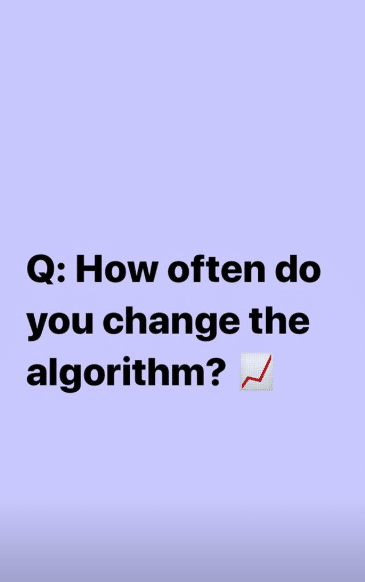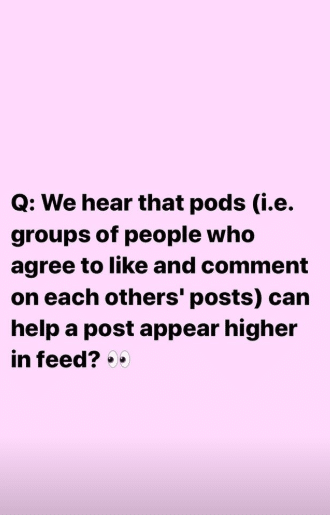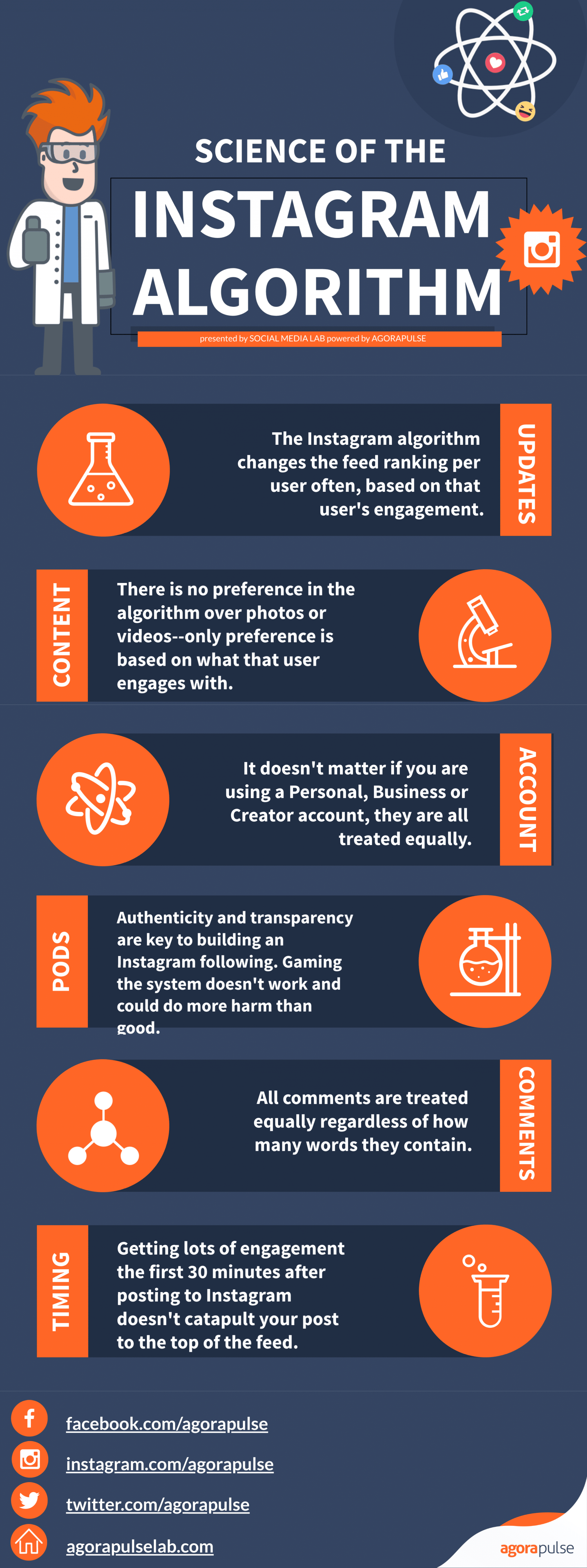
Subscribe to the Social Media Lab Podcast via iTunes | Stitcher | Spotify
How Does the Instagram Algorithm Work?
Understanding the Instagram algorithm is a perplexing and challenging activity for social media managers.
What content works best? Is Instagram punishing my participation in Instagram pods? Does it matter whether I have a personal or business account? The list can go on and on.
Facebook-owned Instagram has never revealed much about the algorithm— until recently.
In a series of Instagram Stories on the Instagram Creators account, Instagram busted common myths about the Instagram algorithm and saved them to its FAQs highlights:
Sharing the nuts and bolts of the Instagram algorithm via Stories is interesting and a tad frustrating for many. I doubt most users would know where to find this information without others telling them.
Instagram answered six common questions regarding the Instagram algorithm:
- How often is the Instagram algorithm changed?
- Does feed ranking favor videos over photos?
- Does the type of account you have impact ranking?
- We hear that pods can help a post appear higher in the feed?
- I’ve heard Instagram doesn’t count something as a comment unless it’s more than 1/2/3 words?
- I’ve heard that the algorithm ranks posts higher that get a lot of likes or comments in the first 30 minutes?
Let’s explore each question. We’ll include screenshots from the Instagram Stories they posted, break down each question, and inspect Instagram’s response.
How Often Is The Instagram Algorithm Changed?
Social Media Lab powered by Agorapulse
How often is the Instagram algorithm changed?: Part 1 of 6 with Jenn Herman
Some users think the Instagram algorithm is constantly changing, and that must be the reason their content no longer performs as well.
Instagram’s response:
Instagram’s algorithm is constantly changing, after all. In fact, it’s likely changing as you are reading this blog post!
But that constant change is a good thing. It ensures that the best content for each user is shown to that person, creating a more enjoyable experience on Instagram.
Instagram delivers a unique feed to every user based on the content they engage with. So, if you see drops in engagement, that could be an algorithm change, but often, as Instagram expert Jenn Hermann points out, the dip could just be because your content is no longer appealing.
See more of what Jenn has to say about the Instagram algorithm changes in this video:
Does Feed Ranking Favor Videos Over Photos?
Social Media Lab powered by Agorapulse
Does Instagram favor videos over photos? Part 2 of 6 with Jenn Herman
With a smartphone in hand, anyone can record video and upload it to Instagram. Instagram is getting feedback that people believe the algorithm favors video more than photos these days:
Instagram’s response is exactly what I assumed it would be:
As I mentioned earlier, the feed is unique per Instagram user, based on what content that user engages with. The Instagram feed is not based on the type of content an account posts to its followers.
So, if you’re a user that never watches videos on Instagram (like me), you probably won’t see many videos in your Instagram feed. And the opposite would be true as well.
I would advise posting a mix of photos and videos to your account, so you have a higher chance of your followers with different preferences seeing and engaging with your content.
Does The Type Of Account You Have Impact Ranking?
Social Media Lab powered by Agorapulse
Does the type of Instagram account you have impact ranking?: Part 3 of 6 with Jenn Herman
Instagram allows users to have three types of accounts:
- Personal
- Business
- Creator
Personal accounts don’t allow any sort of insights to be gathered; Business and Creator do.
There isn’t much difference between the Business or Creator selection. The Business account will allow you to put in your address, phone number, etc. The Creator account setting lets you do some branded partner options. To read more about these, check out this breakdown on Social Media Examiner.
Instagram sought to answer this question:
Instagram vehemently says no:
According to Instagram, it doesn’t matter what the account type is; if a follower engages with the content regularly, then the user will likely see future content from that Instagram account in their feed.
Instagram does make a distinction of simply businesses or verified accounts in their response, perhaps implying celebrities with verified accounts get more prominence in the feed. So, we can’t 100% say based on this response that Personal, Business, and Creator accounts are treated equally, but that’s the assumption.
We Hear That Pods Can Help a Post Appear Higher In The Feed?
Social Media Lab powered by Agorapulse
Do Instagram Pods Help or Hurt? : Part 4 of 6 with Jenn Herman
The Social Media Lab previously tested the impact of Instagram Pods and found no advantage by joining them.
Instagram Pods are a group of people who join together to increase the engagement on Instagram posts with the thought that this engagement causes posts to be seen higher in the feed to other users.
Instagram’s response to the pods reiterates our findings in the Social Media Lab:
Bumping up the engagement numbers on your Instagram posts does not cause those posts to be seen by followers that typically haven’t engaged with you lately.
For example, Bob and Melissa both follow the Agorapulse Instagram account (and you should, too!), but Bob rarely engages with our posts, yet Melissa likes and comments on every post. Melissa’s engagement with Agorapulse’s posts has no impact on Bob seeing posts by Agorapulse.
The Instagram algorithm caters the feed per user to ensure the best experience.
Don’t involve yourself with Instagram pods (or engagement pods on other sites as well) because you’re simply wasting your time.
I’ve Heard Instagram Doesn’t Count Something As a Comment Unless It’s More Than 1/2/3 Words?
Social Media Lab powered by Agorapulse
Do Comments on Instagram need to be more than 3 words? Part 5 of 6 with Jenn Herman
I haven’t seen this rumor floating around, but obviously Instagram has.
Just based on common sense, I find this rumor hard to believe unless the comments were absolute gibberish.
Comments of any size are counted by Instagram and likely weighed equally when it comes to the algorithm and that user’s feed.
On the day Instagram launched these stories busting common algorithm myths, they posted this regarding engagement:
Instagram didn’t elaborate as to any particular ranking regarding engagement types, but suffice it to say, all engagement is important. Comments likely have the highest ranking because they require the most effort by the Instagram user.
I’ve Heard That The Algorithm Ranks Posts Higher That Get A Lot Of Likes Or Comments In The First 30 Minutes?
Social Media Lab powered by Agorapulse
Does the Instagram algorithm rank posts higher that get faster comments? Part 6 of 6 with Jenn Herman
The thought process here is the quicker an Instagram post gets engagement, the higher ranking of that content in the Instagram feed, and perhaps the higher the ranking of future posts from your account to that Instagram user.
Instagram says in its stories that this is false:
Again, Instagram is making it clear that the most important factor in what an Instagram user sees on his/her feed is the accounts they have recently engaged with.
There is no rush to have everyone run over to your Instagram post 5 seconds after it was posted to engage in order to somehow “trick” the algorithm into showing the post to more users. That’s simply not how the Instagram algorithm works.
That’s not to say you shouldn’t pay attention to what is the “best time to post” on your Instagram account. If you’re not getting engagement at 3AM on Tuesdays, stop posting at that time!
You can look at your insights in your Instagram account to get an idea of when your followers are on Instagram the most. But you’ll need to swipe through a few screens to get there and then only be able to look at one day at a time:
This method of finding the best time to post on Instagram for your followers requires a lot of effort. You can toggle between “Hours” and Days” to see when your followers are typically on Instagram.
An easier method is using the reports inside Agorapulse. These reports allow you to see data based on any timeframe you select and data based on engagement or Reach:
These reports are SO much easier to read and understand. Go check out these reports for FREE and after your trial use the coupon code LAB for a free month once you sign up for a plan.
The Science Of The Instagram Algorithm
That Instagram is pulling back the curtains to reveal aspects of the Instagram algorithm is surprising but very helpful.
No doubt these components are only a small portion of what goes into the algorithm, but I love the fact they are busting some of the common myths regarding how the Instagram algorithm works.
To summarize, here’s what we found out about the algorithm:
- The Instagram algorithm changes the feed ranking per user often, based on that user’s engagement.
- There is no preference in the algorithm over photos or videos–only preference is based on what that user engages with.
- It doesn’t matter if you are using a Personal, Business or Creator account. They are all treated equally (but if you want insights you must have a Business or Creator account).
- Instagram Pods are a waste of time!
- All comments are treated equally, regardless of how many words they contain.
- Getting lots of engagement the first 30 minutes after posting to Instagram doesn’t catapult your post to the top of the feed.
Keep in mind all of this information only pertains to the Instagram feed, not Stories. Instagram Stories has a completely different algorithm but is still predominantly based on individual user activity with the accounts they follow.
The quality of your content will dictate where it shows up on the Instagram feed, and your followers engagement levels will let you know quickly whether it’s good or bad.


















